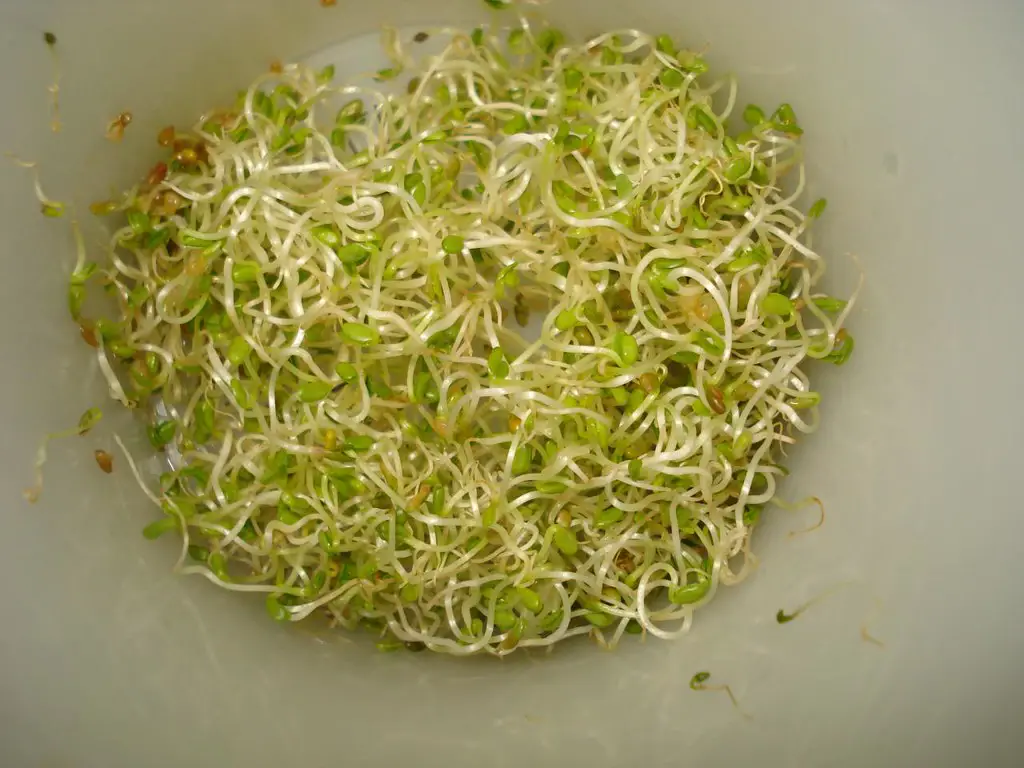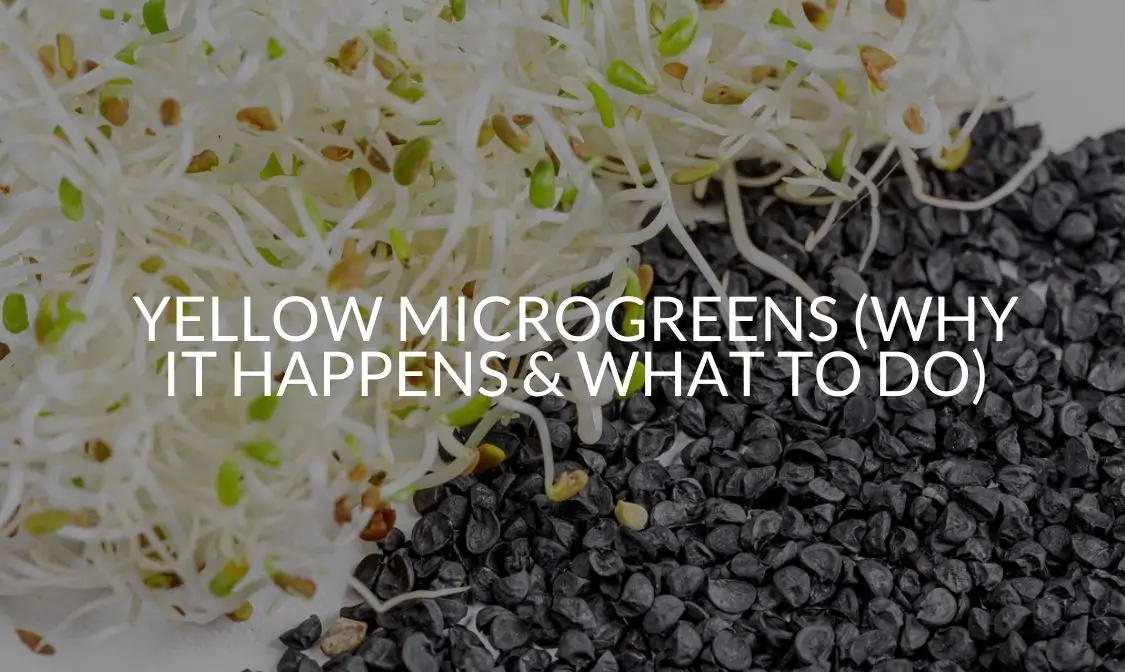Microgreens have steadily gained stellar popularity in the culinary world over the past 3 decades. Initially introduced in the 80s throughout California, microgreens have become a popular favorite. Also known as vegetable confetti or micro herbs, these greens are rich in flavor and add a wonderful fresh splash of color to the dish.
By the name, one would assume that these herbs are always green in appearance, so a slight yellow tinge may startle them. Are they turning bad? Are they inedible? The list of questions goes on.
Well, today, we’ll be taking a look into the phenomena of yellow microgreens. From what yellow microgreens are to distinguishing between rotten or fresh microgreens, we will be taking a comprehensive look at what exactly microgreens are and whether or not you should be worried if they’re yellow.
Why Are Your Microgreens Yellow?
So, why are your microgreens yellow? While there could be a list of potential reasons why your microgreens are yellow, one of the most common reasons is the amount of blackout time provided to the herb plant. Blackout is the period is the time frame during which the plants are placed out of the sun for some time.
Now the reason why the green color in plants exists in the first place is due to the chlorophyll content in the leaves. The production of chlorophyll is linked primarily with the amount of sunlight the plant receives. So, if your plant isn’t receiving the recommended amount of sunlight, naturally, it will start to turn yellow.
Even if you’ve figured out the right balance between blackout and sunlight time, you may see that the microgreens are still looking yellow. This may be because there might even be too much sunlight or a classic case of overwatering.
Another factor that may be affecting the color of the microgreens is the usage of fertilizers. If you’re someone that incorporates the fertilizer within the soil and water, it may be one that doesn’t qualify for the growth of the microgreens itself.
Usually, these herbs don’t require fertilizers due to their short growth period; however, if the soil is not nutritious, you will be required to use a special kind of fertilizer.
Why Do Microgreen Seedlings Turn Yellow?
Why do the seedlings of microgreens turn yellow? This is a particularly tricky question to provide a direct answer to. There might be various factors contributing to why the seedlings are turning yellow. The common factors being the excessive sunlight supply to the plant itself or lack thereof.
Since seedlings are so young, these causes may not be applicable to them. The applicable reasons may be the type of fertilizer used, the quality of soil, aging of leaves, lack of water supply, over watering, lack of nutrients, rotting roots, and what not. The lists of the reasons are focused on more foundational issues.
The yellowing of a seedling is called chlorosis, and that occurs due to lack of chlorophyll production. Like we mentioned earlier, the lesser production of chlorophyll is a result of less light being supplied to the plant itself. It may be possible that your seedlings are placed in an area where the sunlight isn’t properly directed to the pot itself.
How Do You Fix Microgreens Turning Yellow?
So how would you fix the microgreens if they’re turning yellow? Well, if the amount of leaves is more than usual, there may be a deep rooted issue behind all of this. Take a look at the watering frequency as well as the amount of sunlight your plant receives on a daily basis.
Make sure that your plants are receiving at least 12 hours of properly dispersed sunlight and 12 hours of darkness as well. This will maintain the correct chlorophyll production in the plant itself. Similarly, maintaining a good balance on the amount of water received is essential when nurturing your plant. Try to quench the plant’s thirst without overwatering them.
If you’re sure that the water and light frequency is perfect for your microgreens, you may need to re-evaluate the type of fertilizer being used for them. Regular application of fertilizer may prove to be harmful to seedlings. The mineral deposits in the container of the plant itself can create excessive buildup, which suffocates the plant itself.
In case you aren’t using any fertilizer, then the yellowing nature may be due to the lack of nutrients and minerals in the soil itself. Try to experiment with a small amount to see how the herbs respond and build up to an amount that perfectly matches the needs of your microgreens.
If all else fails, pick up the plant and carefully replant it in new soil and newer sunlight direction.
Related Articles
- Microgreens Lighting Guide (All FAQ’s Answered In-Depth!)
- How To Grow Cabbage Microgreens (Benefits, Pests & FAQ)
- Why Are Microgreens So Expensive (And How Much Do They Cost?)
- How To Convert Your Roots From Soil To Water
- How To Grow Asparagus Hydroponically (Complete Guide)

What Microgreens Are Meant To Be Yellow?
While the name suggests that the microgreens will be green, not all of them are meant to be green in nature. Some microgreens are bred carefully across different regions to produce wonderful lustrous colors. Maybe the stem would be different colors or leave, or two will have a unique shade, and sometimes you’ll come across a yellow microgreen.
Yellow popcorn shoot microgreens are an excellent example of naturally yellow microgreens. These are young corn kernels that were sprouted without any exposure to direct sunlight. If you happen to take them out before any light hits them, you will be left with a golden yellow microgreen with a sweet flavor to it.
Another example would be yellow beet microgreens that are partly yellow. You will observe that the stems and veins of the plant itself are yellow with the occasional green leaf or two. Restaurants usually use them to add that aesthetic appeal to the dish overall. And they make up for a crunchy sweet flavor as well.
FAQ
Can A Yellow Leaf Turn Green Again?
The answer to this question is dependent on a few factors, the primary one being the source of the yellowing itself. Some sort of yellowing is curable, while some are pretty much irreversible. Older leaves will tend to shed as the plant ages, and this causes the leaves to turn yellow, which is not reversible.
Yellow leaves may also be due to infections, and this type of yellowing is not reversible either. Overexposure to sunlight or excess water may be the reason behind the yellow microgreens as well, which may be cured by changing the frequency of both these aspects.
As mentioned, the lack of nutrients may be responsible for the yellow microgreens as well, so you can try to increase the nutrient value or change the position of the plant to see if it can help the plant return to its green color. This works in most cases as the nutrient deficiencies lead to the yellow plant itself.
Recap
We hope that with our article, you were able to identify the reason behind the yellow nature of your microgreens. Be sure to properly examine their sunlight intake, their water supply, and of course, the soil quality itself.
We hope that the methods mentioned were useful and you can apply them to your own situation to harvest delicious and healthy microgreens. These herbs can surely contribute to a delicious meal, and taking care of them will help to enhance the appearance and the scrumptious flavor.
Sources
- https://www.allthatgrows.in/blogs/posts/how-to-solve-common-microgreen-problems
- https://www.gardeningknowhow.com/garden-how-to/propagation/seeds/seedlings-turning-yellow.htm
- https://everythinggreen.sg/pages/common-problems-when-growing-microgreens
- https://www.healthline.com/nutrition/10-healthy-herbs-and-spices
- https://www.healthline.com/nutrition/microgreens#bottom-line
- https://www.microgreenscorner.com/common-microgreen-problems-and-how-to-fix-them/
- https://microveggy.com/growing-problems/#5_Yellowish_leggy_and_weak_stems
- https://planthardware.com/yellow-microgreens/

